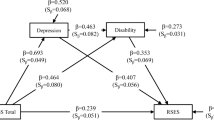Summary
This is the last of a series of three papers dealing with the role of self-esteem in the onset of clinical depression. On the basis of a longitudinal population enquiry a comprehensive psychosocial model of depression is developend. It is concluded that self-esteem (primarily in terms of a negative measure) does play a significant role. However, this can be only properly interpreted in the light of the full model. This highlights: 1. the importance of the occurrence of both a negative enviromental factor (negative interaction with children or husband for married or negative interaction with children or lack of a very close tie for single mothers)and a negative psychological factor (low self-esteem or chronic subclinical condition); and 2. how a relatively small group of high risk women in these terms (23% of total at risk based on measures collected well of onset of depression occurring over a 12 month period.
Similar content being viewed by others
References
Alloy LB, Hartlage S, Abramson LY (1988) In: Alloy LB (ed) Cognitive processes in depression, Guildford, New York
Barnett PA, Gotlib IH (1988) Psychosocial functioning and depression: distinguishing among antecedents, concomitants and consequences. Psychosoc Bull 104: 97–126
Beck AT (1967) Depression: clinical, experimental and theoretical aspects. Staples, London
Beck AT, Rusb AJ, Shaw BF, Emery G (1979) Cognitive therapy of depression. Wiley & Sons, New York
Brewin CR (1985) Depression and causal attributes: what is their relation? Psychol Bull 98: 297–309
Browr GW (1988) Causal paths, chains and strands. In: Rutter M (ed) Studies of psychological risk: the power of longitudinal data. Cambridge University Press, Cambridge
Brown GW (in press) A psychosocial view of depression. In: Bennet DH, Freeman H (eds) Community psychiatry. Churchill-Livingstone, Edinburgh London, New York
Brown GW, Harris TO, (1978) Social origins of depression: a study of psychiatric disorder in women. Tavistock, London, Free Press, New York
Brown GW, Harris TO (1986) Establishing causal links the Bedford College Studies of Depression In: Katschnig H (ed) Life events and psychiatric disorders. Cambridge University Press, Cambridge
Brown GW, Harris TO, Peto J (1973) Life events and psychiatric disorders. 2. Nature of causal link Psychol Med 3: 159–176
Brown GW, Craig TKJ, Harris TO (1985) Depression: disease or distress? Some epidemiological considerations Br J Psychiatry 147: 612–622
Brown GW, Andrews B, Harris TO, Adler Z, Bridge L (1986a) Social support, self-esteem and depression Psychol Med 6: 813–831
Brown GW, Bifulco A, Harris T, Bridge L (1986b) Life stress, chronic psychiatric symptoms and vulnerability to clinical depression. J Affective Disord 11: 1–19
Brown GW, Bifulco A, Harris TO (1987) Life events, vulnerability and onset of depression: some refinements. Br J Psychiatry 150: 30–42
Brown GW, Andrews B, Bifulco A, Veiel H (1990a) Self-esteem and depression. 1. Measurement issues and prediction of onset. Soc Psychiatry Psychiatr Epidemiol 25: 200–209
Brown GW, Bifulco A, Veiel H, Andrews B (1990b) Self-esteem and depression. 2. Social correlates of self-esteem. Soc Psychiatry Psychiatr Epidemiol 25: 225–234
Brown GW, Bifulco A, Andrews B (1990c) Self-esteem and depression. 4. Effect on course and recovery. Soc Psychiatry Psychiatr Epidemiol 25: 244–249
Lewinsohn PM, Steinmetz JL, Larson DW, Franklin J (1981) Depression-related cognitions: antecedent or consequence? J Abnorm Psychol 90: 213–219
O'Connor P, Brown GW (1984) Supportive relationships: fact or fancy? J Soc Pers Relat 1: 159–175
Ortony A, Clore, GL, Collins A (1988) The cognitive structure of emotions. Cambridge University Press, Cambridge
Pyszczynski T, Holt K, Greenberg J (1987) Depression, self-focused attention and expectancies for positive and negative future life events for self and others. J Pers Soc Psychol 52: 994–1001
Riskind JH, Rholes WS (1984) Cognitive accessibility and the capacity of cognitions to predict future depression: a theoretical note. Cogn Ther Res 8: 1–12
Spitzer RL, Endicott JM, Robins E (1978), Research diagnostic criteria: rationale and reliability. Arch Gen Psychiatry 35: 773–782
Teasdale JD (1983) Negative thinking in depression: cause, effect or reciprocal relationship? Adv Behav Res Ther 5: 3–25
Teasdale JD (1988) Cognitive vulnerability to persistent depression. Cogn Emotion 2: 247–274
Author information
Authors and Affiliations
Rights and permissions
About this article
Cite this article
Brown, G.W., Bifulco, A. & Andrews, B. Self-esteem and depression. Soc Psychiatry Psychiatr Epidemiol 25, 235–243 (1990). https://doi.org/10.1007/BF00788644
Accepted:
Issue Date:
DOI: https://doi.org/10.1007/BF00788644




